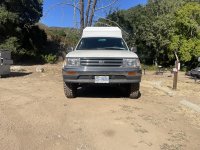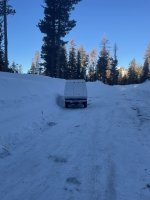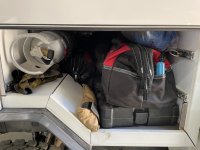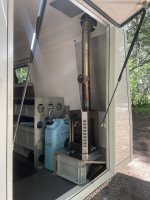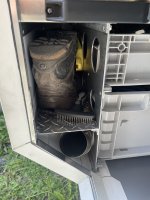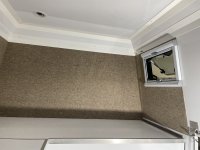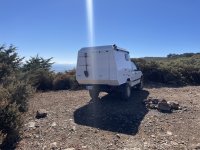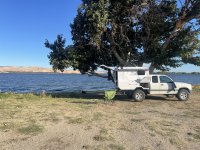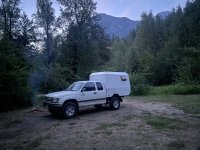
Intro:
Live in British Columbia, Canada and transitioning to a move to the Yukon this Fall. Have spent my adult years in the mountains some way or another. Extensive time hiking and skiing, with lots of time in tents year round around BC, the Yukon and periods in Alaska. As far as using a vehicle, have used many different setups other than a ground tent, on mid-size and a full size trucks over the past 15 or so years: many types of rooftop tents, popup campers, hardshell fiberglass campers and canopies. Weighing the pros and cons of what I’ve had, I was happy using my canopy or ground tent and keeping it simple and light in three seasons, with the occasional Winter night under the canopy to be close by for an early morning ski. Yet overall in Winter, I’d spend less time sleeping out of the truck. Fall into Winter is my favourite time to travel and the places that I enjoy being in the most can or do have rain/hail/snow throughout most months of the year. All in all, I enjoy inclement weather.
About the concept and the builder:
As all I’ve met who have spent extensive time in the mountains, simplicity and weight (as well as weight distribution) are key. Considered shipping the truck to have a camper built in Europe where the manufacturing mindset, processes, materials and engineering were much more in line with what I was looking for, yet the cost of the process felt excessive, even for something I would be living in for up to months, year round. Winter of 2021, researching composite materials for industrial applications I came across Enduro Campers that appeared to share a similar mindset (they had just put up a website and were on their second camper), built products that were engineered (stress analysis being a part of their process for example) and wereinterested in building what I wanted within my price range, even on an old T100!
The concept was a hardshell, sitting height cabin that was directly mounted to the chassis (light, low, smaller footprint). It’s weight and weight distribution were to be well within the optimal parameters of the truck to maintain longevity/durability, driving characteristics on and off road, simplicity of ownership and upfront + maintenance costs. I wanted to be able to carry items that you would usually just toss in the back of your bed within the wheelbase, not behind it: chainsaw, tools, spares, additional gas, additional water when needed, wood, tents, ski gear etc. Also, this wasn’t meant to replace a home – I still wanted to feel like I was camping. Cook outside, spend time outside or under the awning, etc, …. This mindset is also what enables the truck to meet its weight requirement and allows it to be such a pleasure to drive on and off road with minimal alterations from stock.
The folks at Enduro Campers quickly picked up on what I was after: essentials without excess for comfort and well-being in all weather and conditions, thanks to an efficient envelop and relatively minimalist mindset. I was thrilled that their first renderings of my hand drawn sketches and notes were already very close to what I had in mind. Over the course of the build, the expertise of the team made the concept into reality andperfected aspects of the idea. I am impressed with the quality of their work and overall thoroughness. Working in developmentand manufacturing, this is all the more notable being a one-offentirely custom project (as of today, they are open to building more in the future).
Super Tourer hardshell cabin parameters:
Enduro build the cabin and installed the woodstove which I picked up in January 2023 and I have been building up the interior since myself and with the help of good friends.
-Enduro Campers’ thickest panels on all walls and roof, including fenderwells and internal garage walls: 1.625”. Floor is 2.75” I believe. Frequently in -20C and below in Winter.

-Tern Overland’s smallest windows and two only, to avoid heat loss and placed for air flow. The rear one can be cracked for airflow to the woodstove without creating excessive draft in the front of the camper.


-Rear door (not side) to favour a forward weight distribution of internal items and still have a wide enough door and aisle to toss wood in there, heavier, bulkier dirty items as need be when I’m not camping. A utility trailer will do the bigger, heavier, dirtier work.
-Door was to be one piece and open vertically to serve as a simple awning to sit under, change under, take boots on and off under, towel off the dog under, …. and cook a quick breakfast/coffee/lunch under without any setup-tear down time.


-Kitchen outside access to reach the pantry easily when cooking under the awning, or use as a table to put things on etc.
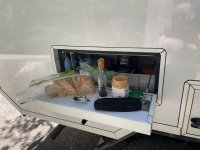


-Same width and length as the truck (bumper to bumper stock), just enough height to sit up without having the thought of hitting your head and have an overall total height of under 8ft (ground to top of roof with 235/85/16 tires). I believe about 20” above cab. T100 having a low top of cab to top of frame rail measurement has the camper looking taller than it is.

Last edited:

